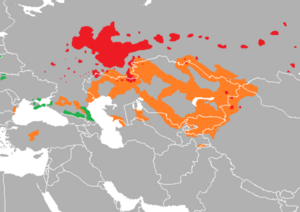Kipchak languages
The Kipchak or north-west Turkish languages are a branch of the Turkic languages , the distribution of which extends from Europe through Central Asia to China and which include around 20 million native speakers.
structure
Ancient Kipchak languages
- Kipchak (†)
- Cuman or Coman (†)
Modern Kipchak languages
- Bashkir
- Karaim
- Karakalpak
- Karachay-Balkar
- Kazakh
- Kyrgyz
- Crimean Tatar
- Crimean Chakish
- Kumyk
- Nogaisch
- Tatar
Linguistically related to these languages, one still counts the Urum of the Graecotatars . Both Urum and Crimean Tatar are genuinely Kipchak languages, but they are influenced by the oghusian . It is also assumed that the language of at least some of the Mamluks belonged to the western branch of Kipchak.
In addition, some Turkologists break down Karachay-Balkar, which is two dialects of a single language, into the “individual languages” Karachay and Balkar .
classification
-
Turkic languages
-
Kipchak ( Northwest Turkish )
- West Crimean Tatar, Urum, Crimchak, Kumyk, Karachay-Balkar, Karaim, Kipchak and Kuman both †
- North Tatar, Bashkir
- South Kazakh, Kyrgyz, Karakalpak, Nogai
-
Kipchak ( Northwest Turkish )
| language | Number of speakers | mainly widespread in the following countries (with number of speakers) |
| Karaim | nearly † | Lithuania 20, Ukraine <10, Poland <10 |
| Kumyk | 280,000 | Russia ( Dagestan ) |
| Karachay-Balkar | 250,000 | Russia ( Karachay-Cherkessia , Kabardino-Balkaria ) |
| Crimean Tatar | 500,000 | Ukraine 200,000, Uzbekistan 190,000, Kyrgyzstan 40,000 |
| Urum (language) | 190,000 | Ukraine , Georgia , Greece |
| Crimean Chakish | ~ 100 | Ukraine , Israel , Russia |
| Tatar | 6.5 million |
Russia 5.3 million, Uzbekistan 470,000, Kazakhstan 330,000, Kyrgyzstan 70,000, Tajikistan 80,000, Turkmenistan 50,000, Ukraine 90,000, Azerbaijan 30,000 ethnic Tatars : 6.6 million |
| Bashkir | 1.8 million | Russia 1.7 million, Uzbekistan 35,000, Kazakhstan 20,000 |
| Nogaisch | 70,000 | Russia ( North Caucasus ) |
| Karakalpak | 400,000 | Uzbekistan |
| Kazakh | 11 million | Kazakhstan 8 million, PR China 1 million, Uzbekistan 800,000, Russia 650,000, Mongolia 100,000 |
| Kyrgyz | 3.7 million | Kyrgyzstan 3.3 million, Uzbekistan 200,000, PR China 200,000 |
